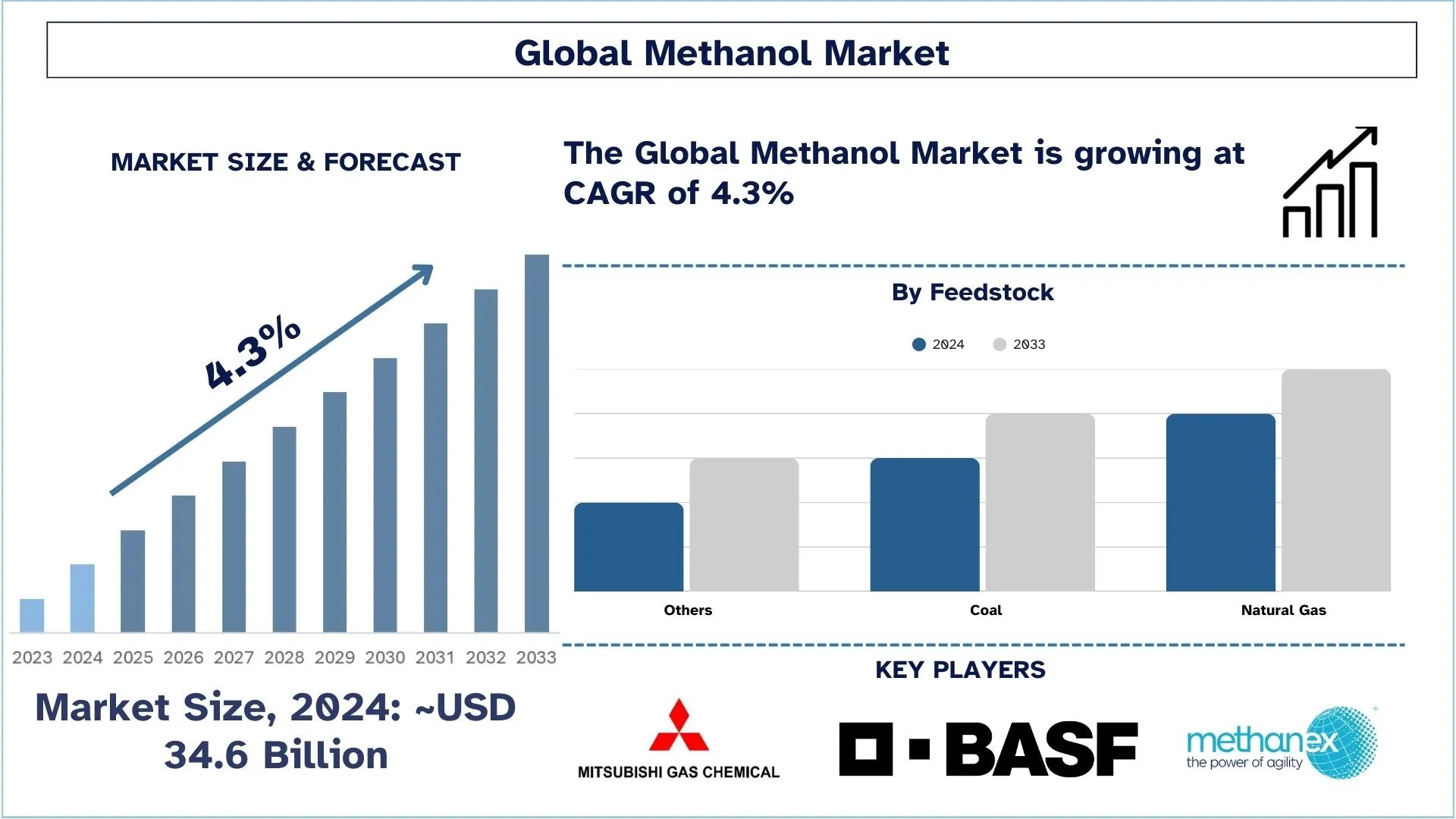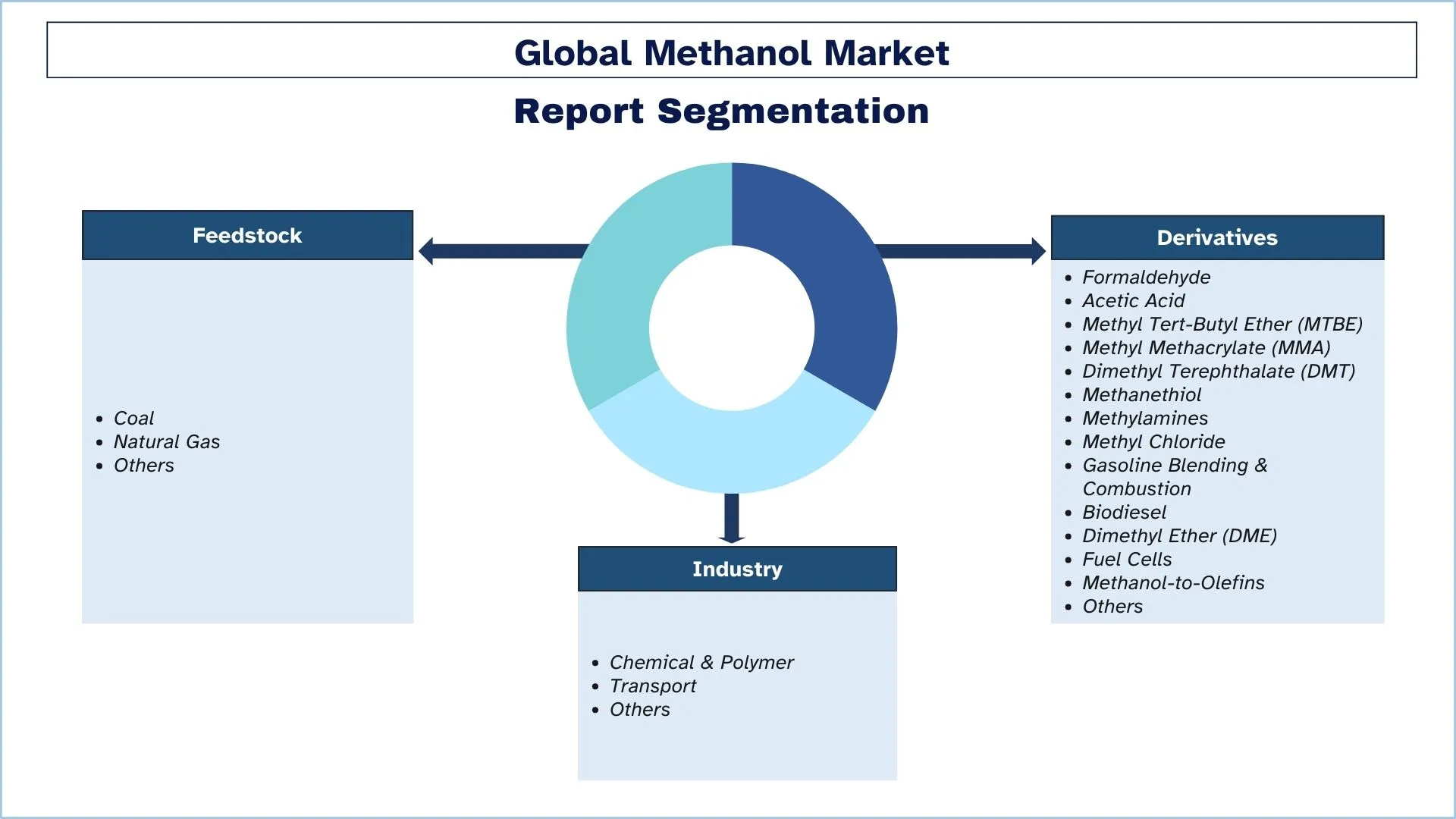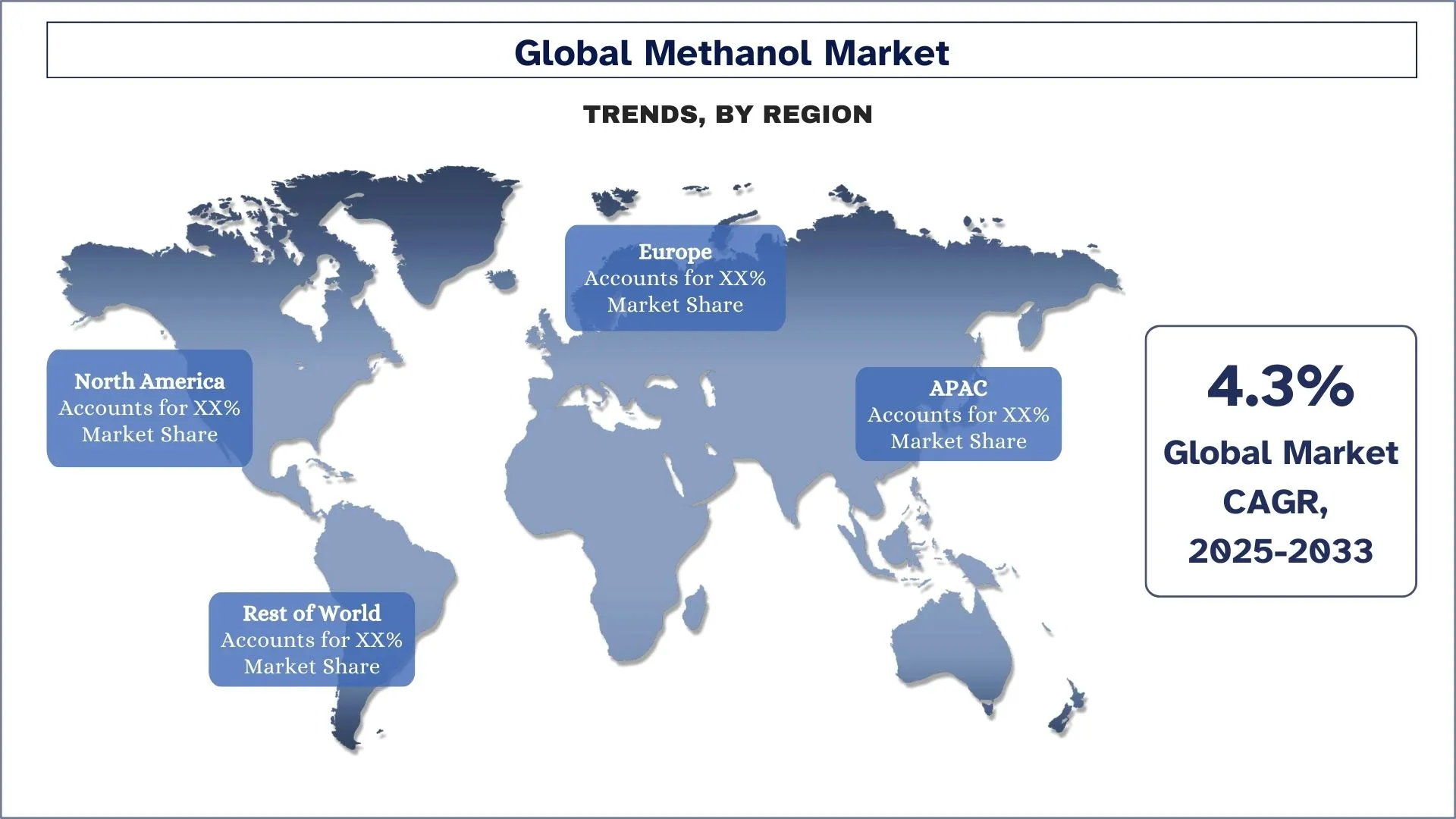Methanol Market: Current Analysis and Forecast (2025-2033)
Emphasis by Feedstock (Coal, Natural Gas, and Others); Derivatives (Formaldehyde, Acetic Acid, Methyl Tert-Butyl Ether (MTBE), Methyl Methacrylate (MMA), Dimethyl Terephthalate (DMT), Methanethiol, Methylamines, Methyl Chloride, Gasoline Blending & Combustion, Biodiesel, Dimethyl Ether (DME), Fuel Cells, Methanol-to-Olefins, and Others); Industry (Chemical & Polymer, Transport, and Others); and Region and Country

Methanol Market Size & Forecast
The methanol market was valued at approximately USD 73.8 billion in 2024 and is expected to grow at a substantial CAGR of around 10.3% during the forecast period (2025-2033), owing to the growing Methanol pipeline.
Methanol Market Analysis
Methanol is a key product in the chemical industry. It is mainly used for producing other chemicals such as formaldehyde, acetic acid, MTBE, MMA, and DMT, among others. Therefore, the demand for methanol depends on the production of chemicals. For instance, a product like formaldehyde is an important raw material in the production of a wide range of products like particleboard, plywood, and fiberboard; glues and adhesives; permanent-press fabrics; paper products, coatings; and certain insulation materials. Further, it is used in the production of food, paints & coatings, and disinfectants. Since the demand for building products is increasing on account of rising construction activities in the developing economies, coupled with the growing market for food, paint & coatings, and pharmaceuticals, owing to increasing urbanization and growing population, this is propelling the demand for formaldehyde. Moreover, several companies are manufacturing products that can run on methanol fuel. For instance, Thermax Ltd. has developed a 5 KW methanol-based reformer on a Direct Methanol Fuel Cell (DMFC). This module is being tested to replace DG sets in mobile towers. The above factors will fuel the methanol market.
Methanol Market Trends
This section discusses the key market trends influencing the various segments of the Methanol market as identified by our research experts.
Rapid Expansion of Methanol-to-Olefins (MTO) Technology
MTO technology is one of the most prominent trends influencing the condition of the methanol market in China. Thus, with the country gradually turning towards more domestic production of crude oil, MTO can offer practical conversion of coal-based methanol into crucial petrochemicals such as ethylene and propylene. This is in line with China’s strategic goals of achieving industrialization and diversifying its sources of energy. With the backing of government support and the advance of technology, MTO is playing a major role in increasing the demand for methanol in the domestic market and changing the global supply chain.

Methanol Industry Segmentation
This section provides an analysis of the key trends in each segment of the global Methanol report, along with forecasts at the global, regional, and country levels for 2025-2033.
The Formaldehyde Market Holds the Largest Share of the Methanol Market.
Based on derivatives, the market is categorized into formaldehyde, acetic acid, MTBE, MMA, DMT, methanethiol, methylamines, methyl chloride, gasoline blending & combustion, biodiesel, DME, fuel cells, methanol-to-olefins, and others. Among these, the formaldehyde market has a considerable share of the methanol industry. Formaldehyde is an important raw material in the production of a wide range of products like particleboard, plywood, and fiberboard; glues and adhesives; permanent-press fabrics; paper product coatings; and certain insulation materials. Further, it is used in the production of food, paints & coatings, and disinfectants. Therefore, with rising construction activities in the region, demand for the products would also increase, thus increasing the consumption of formaldehyde.
The Chemical & Polymer Market is Expected to Witness a Higher CAGR than the Methanol Market.
Based on industry, the market is categorized into chemical & polymer, transport, and others. Among these, chemicals & polymers have a considerable share in the methanol market due to the production of many chemical-related methanol derivatives. Derivatives like formaldehyde, MTBE, and acetic acid are among the largest consumers of methanol, which is produced in the chemical industry. Further, increasing construction activities due to rising urbanization and growing population, along with improving consumer disposable power, which resulted in home decoration activities, are propelling the demand for building materials. Thus, increasing the consumption of methanol derivatives like formaldehyde, as a result, improves the market share of chemicals & polymers.
Asia-Pacific has a significant share of the market in 2024.
Asia-Pacific accounted for a significant share of the market and is expected to showcase substantial growth during the forecast period. This can be ascribed to the large and growing base of the chemical industry. Also, the region is the largest producer of chemicals across the globe. Further, the region has an abundance of coal and natural gas, which can be converted into methanol through gasification and reforming. The production of methanol from natural gas reforming is a mature technology. This has helped the region to capture a prominent position in the market.
China Dominates the Asia-Pacific Methanol Market
Methanol industry in China is significant, and it is China is the largest producer of methanol and consumer in the world, thus making their role in the global market significant. The country’s methanol industry is highly linked with coal-based production, while other areas depend more on natural gas. Methanol is widely used in China’s economy and industries in sectors including formaldehyde production, olefins, fuels, and more recently as a fuel for transport. This has been attributed to government support accorded to methanol vehicles, along with recent technological developments in MTO conversions. However, the Chinese methanol market seems quite healthy owing to industrial consumption and a quest for new energy sources.

Methanol Industry Competitive Landscape
The Methanol market is competitive, with several global and international players. The key players are adopting different growth strategies to enhance their market presence, such as partnerships, agreements, collaborations, new product launches, geographical expansions, and mergers and acquisitions.
Top Methanol Companies
Some of the major players operating in the market are Methanex Corporation, BASF SE, Mitsubishi Gas Chemical Company, Mitsui & Co. Ltd., Metafrax Chemicals, Petronas, Yanzhou Coal Mining Company Ltd. (Yankuang Group), Shanghai Huayi (Group) Company, Ningxia Baofeng Energy Group Co. Ltd., and Celanese Corporation.
Recent Developments in the Methanol Market
In April 2023, Methanex Corporation signed an agreement with Suez Methanol Derivatives (SMD) for a new methanol pipeline. With this agreement, Methanex Corporation will supply methanol from its Egypt plant to a nearby SMD company’s project in Damietta.
In March 2023, Zagros Petrochemical Company (ZPC) and Dalian Petrochemical Company signed an agreement to construct a methanol-to-synthetic ethanol conversion plant.
In March 2021, Celanese Corporation announced that it would expand its capacity, and it’s Clear Lake, Texas integrated chemical manufacturing facility would begin utilizing recycled carbon dioxide (CO2) as an alternative feedstock in the production of methanol.
Methanol Market Report Coverage
Details | |
Base year | 2024 |
Forecast period | 2025-2033 |
Growth momentum | Accelerate at a CAGR of 10.3% |
Market size 2024 | USD 73.8 Billion |
Regional analysis | North America, Europe, Asia-Pacific, Rest of the World |
Major contributing region | APAC is expected to grow at the highest CAGR during the forecasted period. |
Key countries covered | U.S., Canada, Germany, France, UK, Spain, Italy, China, Japan, and India |
Methanex Corporation, BASF SE, Mitsubishi Gas Chemical Company, Mitsui & Co. Ltd., Metafrax Chemicals, Petronas, Yanzhou Coal Mining Company Ltd. (Yankuang Group), Shanghai Huayi (Group) Company, Ningxia Baofeng Energy Group Co. Ltd., and Celanese Corporation | |
Report Scope | Market Trends, Drivers, and Restraints; Revenue Estimation and Forecast; Segmentation Analysis; Demand and Supply Side Analysis; Competitive Landscape; Company Profiling |
Segments Covered | By Feedstock, By Derivatives, By Industry, By Region/Country |
Reasons to Buy the Methanol Market Report:
The study includes market sizing and forecasting analysis validated by authenticated key industry experts.
The report presents a quick review of overall industry performance at a glance.
The report covers an in-depth analysis of prominent industry peers with a primary focus on key business financials, product portfolios, expansion strategies, and recent developments.
Detailed examination of drivers, restraints, key trends, and opportunities prevailing in the industry.
The study comprehensively covers the market across different segments.
Deep dive regional-level analysis of the industry.
Customization Options:
The global Methanol market can be customized further as per the requirements or any other market segment. Besides this, UnivDatos understands that you may have your own business needs; hence, feel free to contact us to get a report that completely suits your requirements.
Table of Contents
Research Methodology for Methanol Market Analysis (2023-2033)
We analyzed the historical market, estimated the current market, and forecasted the future market of the global Methanol market to assess its application in major regions worldwide. We conducted exhaustive secondary research to gather historical market data and estimate the current market size. To validate these insights, we carefully reviewed numerous findings and assumptions. Additionally, we conducted in-depth primary interviews with industry experts across the Methanol value chain. After validating market figures through these interviews, we used top-down and bottom-up approaches to forecast the overall market size. We then employed market breakdown and data triangulation methods to estimate and analyze the market size of industry segments and sub-segments.
Market Engineering
We employed data triangulation techniques to finalize the overall market estimation and derive precise statistical numbers for each segment and sub-segment of the global Methanol market. We split the data into several segments and sub-segments by analyzing various parameters and trends, including feedstock, derivatives, industry, and regions within the global Methanol Market.
The main objective of the Global Methanol Market Study is to
The study identifies current and future trends in the global Methanol market, providing strategic insights for investors. It highlights regional market attractiveness, enabling industry participants to tap into untapped markets and gain a first-mover advantage. Other quantitative goals of the studies include:
Market Size Analysis: Assess the current and forecast market size of the global Methanol Market and its segments in terms of value (USD).
Methanol Market Segmentation: The study segments the market by feedstock, derivatives, industry, and region.
Regulatory Framework & Value Chain Analysis: Examine the regulatory framework, value chain, customer behavior, and competitive landscape of the Methanol industry.
Regional Analysis: Conduct a detailed regional analysis for key areas such as Asia Pacific, Europe, North America, and the Rest of the World.
Company Profiles & Growth Strategies: Company profiles of the Methanol Market and the growth strategies adopted by the market leaders to sustain the fast-growing market.
Frequently Asked Questions FAQs
Q1: What is the Methanol market's current size and growth potential?
The global methanol market is valued at approximately USD 73.8 billion in 2024 and is projected to grow at a robust CAGR of 10.3% through 2033.
Q2: What are the driving factors for the growth of the Methanol market?
Globally, methanol is gaining traction as a cleaner-burning alternative fuel for vehicles, marine transport, and power generation, driven by efforts to reduce greenhouse gas emissions and comply with stricter environmental regulations.
Q3: Which market has the largest share of the Methanol market by feedstock?
The natural gas category currently holds the largest market share.
Q4: What are the major trends in the Methanol market?
The global methanol market is being propelled by its increasing use in the production of formaldehyde, acetic acid, and olefins, along with rising demand from the automotive sector for fuel and fuel additives.
Q5: Which region will dominate the Methanol market?
The APAC region currently dominates the global methanol market.
Q6: What are the biggest challenges in the Methanol market?
Fluctuations in natural gas and coal prices, along with environmental concerns around carbon emissions, especially from coal-based production, pose significant challenges to stable methanol supply and sustainable growth.
Q7: Who are the Top players in the global Methanol market?
The leading companies driving innovation in Methanol include:
• Methanex Corporation
• BASF SE
• Mitsubishi Gas Chemical Company
• Mitsui & Co. Ltd.
• Metafrax Chemicals
• Petronas
• Yanzhou Coal Mining Company Ltd. (Yankuang Group)
• Shanghai Huayi (Group) Company
• Ningxia Baofeng Energy Group Co., Ltd.
• Celanese Corporation
Q8: Which industries are the primary consumers of methanol in the global market?
Key end-use industries include petrochemicals, construction, automotive, and energy, where methanol is used in producing formaldehyde, acetic acid, olefins, and as a fuel additive.
Q9: How are emerging technologies influencing the global methanol market?
Innovations in methanol production, such as carbon capture integration and green methanol from renewable sources, are transforming the market by enhancing sustainability and aligning with global decarbonization goals.
Related Reports
Customers who bought this item also bought










